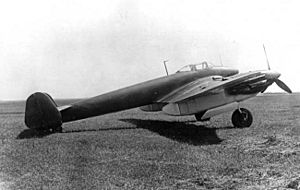Mikoyan-Gurevich DIS facts for kids
The Mikoyan-Gurevich MiG DIS was a special type of fighter aircraft designed in the Soviet Union during World War II. The letters "DIS" stood for "Dalniy Istrebitel Soprovzhdeniya," which means "Long-Range Escort Fighter." This plane was planned to fly long distances and protect other aircraft, like bombers. Only two test versions, called prototypes, were ever built. The project was eventually stopped before the plane could be made in large numbers.
Contents
What Was the MiG DIS?
The MiG DIS was designed by the Mikoyan-Gurevich design bureau, a famous aircraft company in the Soviet Union. It was meant to be a powerful and versatile aircraft. The designers hoped it could do many jobs, like escorting bombers, attacking enemy planes, and even performing reconnaissance (gathering information).
Designing a New Fighter
The idea for the MiG DIS started in 1940. The Soviet military wanted a new fighter that could fly further and carry more weapons than existing planes. The MiG DIS was designed with two engines, which was unusual for a fighter at that time. This twin-engine design gave it more power and allowed it to carry heavy guns.
Key Features of the MiG DIS
The MiG DIS had a unique design. It was a low-wing aircraft, meaning its wings were attached near the bottom of the fuselage. It also had a tricycle landing gear, with a nose wheel and two main wheels. This made it easier to land and take off. The plane was planned to have powerful cannons and machine guns. These weapons would help it fight enemy aircraft or attack targets on the ground.
Why Prototypes Are Built
Building prototypes is a very important step when creating new aircraft. A prototype is like a test version of a new invention. Engineers and designers build them to see if their ideas work in the real world.
Testing New Ideas
When a new aircraft is designed, it looks great on paper. But flying it is different. Prototypes help engineers test how the plane handles in the air. They check its speed, how well it turns, and if all its systems work correctly. This testing helps them find and fix any problems before many planes are built.
Learning from Prototypes
The two MiG DIS prototypes were used for these important tests. Engineers learned a lot from flying them. They gathered information about the plane's performance and identified areas that needed improvement. This process is crucial for making sure that final aircraft designs are safe and effective.
The End of the Project
Even though the MiG DIS showed promise, the project was cancelled. This often happens with military aircraft designs. There are many reasons why a promising project might not go into full production.
Changing War Needs
World War II was a time of rapid change in aircraft design. New technologies and new combat needs appeared quickly. Sometimes, a plane that seemed perfect at one point might become less useful as the war changed. Other aircraft designs might have been developed that were better suited for the current needs.
Focusing on Other Designs
The Soviet Union had many aircraft projects happening at the same time. Resources, like materials and skilled workers, were limited. The government might have decided to focus on other fighter planes that were simpler to build or already closer to production. This was a common decision during wartime, when speed and efficiency were very important.
Images for kids
See also
 In Spanish: Mikoyan-Gurevich DIS para niños
In Spanish: Mikoyan-Gurevich DIS para niños



